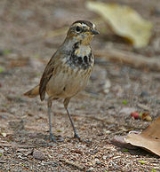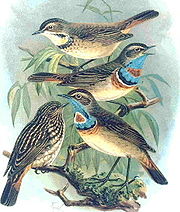
Bluethroat
Encyclopedia
The Bluethroat is a small passerine
bird
that was formerly classed as a member of the thrush
family Turdidae, but is now more generally considered to be an Old World flycatcher
, Muscicapidae. It, and similar small Europe
an species, are often called chat
s.
-_female_at_bharatpur_i_img_5484.jpg)
 It is a migratory
It is a migratory
insectivorous species breeding in wet birch
wood or bushy swamp in Europe
and Asia
with a foothold in western Alaska
. It nests in tussocks or low in dense bushes. It winters in north Africa
and northern Pakistan.
The Bluethroat is similar in size to the European Robin
at 13–14 cm. It is plain brown above except for the distinctive black tail with red side patches. It has a strong white supercilium.
The male has a blue bib edged below with successive black, white and rust coloured borders. Some races, such as L. svecica svecica (Red-spotted Bluethroat) of northern Eurasia, have a red spot in the centre of the blue bib.
Others, such as L. svecica cyanecula (White-spotted Bluethroat) of southern and central Europe, have a white spot in the centre of the blue bib. L. svecica magna in Turkey has no central spot.
Females of all races usually have just a blackish crescent on an otherwise cream throat and breast. Newly fledged juveniles are freckled and spotted dark brown above.
Despite the distinctive appearance of the males, recent genetic studies show only limited variation between the forms, and confirm that this is a single species.
The male has a varied and very imitative song . Its call is a typical chat “chack” noise.
Passerine
A passerine is a bird of the order Passeriformes, which includes more than half of all bird species. Sometimes known as perching birds or, less accurately, as songbirds, the passerines form one of the most diverse terrestrial vertebrate orders: with over 5,000 identified species, it has roughly...
bird
Bird
Birds are feathered, winged, bipedal, endothermic , egg-laying, vertebrate animals. Around 10,000 living species and 188 families makes them the most speciose class of tetrapod vertebrates. They inhabit ecosystems across the globe, from the Arctic to the Antarctic. Extant birds range in size from...
that was formerly classed as a member of the thrush
Thrush (bird)
The thrushes, family Turdidae, are a group of passerine birds that occur worldwide.-Characteristics:Thrushes are plump, soft-plumaged, small to medium-sized birds, inhabiting wooded areas, and often feed on the ground or eat small fruit. The smallest thrush may be the Forest Rock-thrush, at and...
family Turdidae, but is now more generally considered to be an Old World flycatcher
Old World flycatcher
The Old World flycatcher family Muscicapidae is a large family of small passerine birds mostly restricted to the Old World. These are mainly small arboreal insectivores, many of which, as the name implies, take their prey on the wing.-Characteristics:...
, Muscicapidae. It, and similar small Europe
Europe
Europe is, by convention, one of the world's seven continents. Comprising the westernmost peninsula of Eurasia, Europe is generally 'divided' from Asia to its east by the watershed divides of the Ural and Caucasus Mountains, the Ural River, the Caspian and Black Seas, and the waterways connecting...
an species, are often called chat
Chat (bird)
Chats are a group of small Old World insectivorous birds formerly classed as members of the thrush family Turdidae, but now considered Old World flycatchers....
s.
-_female_at_bharatpur_i_img_5484.jpg)

Bird migration
Bird migration is the regular seasonal journey undertaken by many species of birds. Bird movements include those made in response to changes in food availability, habitat or weather. Sometimes, journeys are not termed "true migration" because they are irregular or in only one direction...
insectivorous species breeding in wet birch
Birch
Birch is a tree or shrub of the genus Betula , in the family Betulaceae, closely related to the beech/oak family, Fagaceae. The Betula genus contains 30–60 known taxa...
wood or bushy swamp in Europe
Europe
Europe is, by convention, one of the world's seven continents. Comprising the westernmost peninsula of Eurasia, Europe is generally 'divided' from Asia to its east by the watershed divides of the Ural and Caucasus Mountains, the Ural River, the Caspian and Black Seas, and the waterways connecting...
and Asia
Asia
Asia is the world's largest and most populous continent, located primarily in the eastern and northern hemispheres. It covers 8.7% of the Earth's total surface area and with approximately 3.879 billion people, it hosts 60% of the world's current human population...
with a foothold in western Alaska
Alaska
Alaska is the largest state in the United States by area. It is situated in the northwest extremity of the North American continent, with Canada to the east, the Arctic Ocean to the north, and the Pacific Ocean to the west and south, with Russia further west across the Bering Strait...
. It nests in tussocks or low in dense bushes. It winters in north Africa
Africa
Africa is the world's second largest and second most populous continent, after Asia. At about 30.2 million km² including adjacent islands, it covers 6% of the Earth's total surface area and 20.4% of the total land area...
and northern Pakistan.
The Bluethroat is similar in size to the European Robin
European Robin
The European Robin , most commonly known in Anglophone Europe simply as the Robin, is a small insectivorous passerine bird that was formerly classed as a member of the thrush family , but is now considered to be an Old World flycatcher...
at 13–14 cm. It is plain brown above except for the distinctive black tail with red side patches. It has a strong white supercilium.
The male has a blue bib edged below with successive black, white and rust coloured borders. Some races, such as L. svecica svecica (Red-spotted Bluethroat) of northern Eurasia, have a red spot in the centre of the blue bib.
Others, such as L. svecica cyanecula (White-spotted Bluethroat) of southern and central Europe, have a white spot in the centre of the blue bib. L. svecica magna in Turkey has no central spot.
Females of all races usually have just a blackish crescent on an otherwise cream throat and breast. Newly fledged juveniles are freckled and spotted dark brown above.
Despite the distinctive appearance of the males, recent genetic studies show only limited variation between the forms, and confirm that this is a single species.
The male has a varied and very imitative song . Its call is a typical chat “chack” noise.
External links
- Bluethroat song on Sonatura audioblog
- Bluethroat videos, photos & sounds on the Internet Bird Collection
- Ageing and sexing (PDF) by Javier Blasco-Zumeta
- Information and pictures about the Bluethroat in the Netherlands
- Avibase

